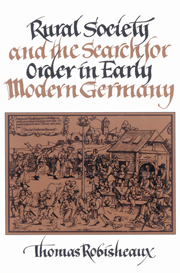Book contents
- Frontmatter
- Contents
- List of illustrations and tables
- Acknowledgments
- A note on usages
- Glossary
- List of abbreviations
- Introduction
- Part One Agrarian expansion, revolt, and the decay of community
- 1 Anatomy of a rural society
- 2 Peasants' War and reformation
- 3 Rich and poor
- Part Two Search for order
- Part Three Crisis and recovery
- Appendix A Distribution of wealth in Langenburg district, 1528–1581
- Appendix B Grain production and the peasant household
- Manuscript sources
- Bibliographical essay
- Index
2 - Peasants' War and reformation
Published online by Cambridge University Press: 05 May 2010
- Frontmatter
- Contents
- List of illustrations and tables
- Acknowledgments
- A note on usages
- Glossary
- List of abbreviations
- Introduction
- Part One Agrarian expansion, revolt, and the decay of community
- 1 Anatomy of a rural society
- 2 Peasants' War and reformation
- 3 Rich and poor
- Part Two Search for order
- Part Three Crisis and recovery
- Appendix A Distribution of wealth in Langenburg district, 1528–1581
- Appendix B Grain production and the peasant household
- Manuscript sources
- Bibliographical essay
- Index
Summary
No set of events illustrates more clearly the tenuousness of order and the weakness of princely domination of the countryside than do the risings of 1525. During the Peasants' War villagers not only challenged the authority of their lords and called into question the fundamental order of feudal society, they also began to fashion a radical new world to replace it. In some ways, the dynamics of the revolt were determined by the social, political, and economic strains common to many rural societies in Europe at the beginning of this long period of agrarian expansion in the sixteenth century. But the revolt also had its roots in the electrifying religious and political climate of South and Central Germany in the early 1520s. For the leaders of the German peasants, as they drew up grievance lists and hammered out political programs for the new order, built upon the bundle of complex ideas associated with the early evangelical movements.
One must be careful not to read into these plans the ideas of Luther, Zwingli, or any other great reformer, although these reformers certainly influenced the shaping of some of them. These political plans, like the revolt itself, must be understood in the context of the complex inner dynamics of the peasant movements, the shifting, often contradictory, goals of the groups that made up the armies.
- Type
- Chapter
- Information
- Publisher: Cambridge University PressPrint publication year: 1989
- 1
- Cited by



